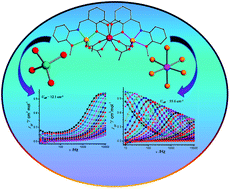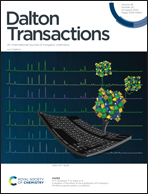Influence of anion induced geometry change in Zn(ii) on the magnetization relaxation dynamics of Dy(iii) in Zn–Dy–Zn complexes†
Abstract
A family of hetero-trinuclear metal complexes with the general molecular formula [Zn2Dy(L1)2(OAc)4] (X) where X = (NO3)0.92(Br)0.08 (1), ClO4 (2), Cl (3) and PF6 (4) were structurally characterized using a Schiff base ligand (HL1). The Dy(III) ion in 1–4 exhibits distorted square anti-prism geometry; however, the extent of distortion observed around Dy(III) in these complexes differ from each other. Consequently, 1–4 show distinct magnetization relaxation dynamics, with the anisotropic energy barrier of 25.4 cm−1, 12.9 cm−1, 14.08 cm−1 and 55.5 cm−1, respectively. The detailed electronic structure of 1–4 and the experimentally observed magnetization relaxation dynamics trends were rationalized using ab initio calculations. The detailed investigation discloses the non-zero influence of the anion themselves and the anion induced geometry change in Zn(II) affects the electronic structure of Dy(III), which in turn affects the magnetization relaxation dynamics. Overall, the study unveils an unprecedented methodology i.e. change in geometry of Zn(II) by altering the anion in the crystal lattice to modulate the relaxation dynamics of Dy(III).



 Please wait while we load your content...
Please wait while we load your content...